These NCERT Solutions for Class 8 Science Chapter 16 Light Questions and Answers are prepared by our highly skilled subject experts to help students while preparing for their exams.
Light NCERT Solutions for Class 8 Science Chapter 16
Class 8 Science Chapter 16 Light Textbook Exercise Questions and Answers
Page 212-213
Question 1.
Suppose you are in a dark room. Can you see objects in the room? Can you see objects outside the room? Explain.
Answer:
It is not possible to see in a dark room because of absence of light. We know that we are able to see something when light falls on it. If there is light outside the room, the objects outside the room can be seen.
Question 2.
Differentiate between regular and diffused reflection. Does diffused reflection mean the failure of the laws of reflection?
Answer:
Difference between regular and diffused reflection:
| Regular reflection | Diffused reflection |
| 1. For the same direction of incident rays, the reflected rays are produced in the same direction. | 1. The reflected rays are produced in different directions. |
| 2. It occurs when incident ray falls on a smooth or polished surface. | 2. It occurs when incident ray falls on a rough surface. |
Diffused reflection is not due to the failure of the laws of reflection. It is caused by the irregularities in the reflecting surface.
Question 3.
Mention against each of the following whether regular or diffused reflection will take place when a beam of light strikes. Justify your answer in each case.
a. Polished wooden table
b. Chalk powder
c. Cardboard surface
d. Marble floor with water spread over it
e. Mirror
f. Piece of paper
Answer:
a. Regular reflection will occur because it is a smooth surface.
b. Diffused reflection will take place because it is a rough surface
c. Diffused reflection will take place because it is a rough surface having irregularities.
d. Diffused reflection will take place because marble and water will form prism.
e. Regular reflection will take place because plane mirror is a smooth surface.
f. Diffused reflection will take place because paper is a rough surface.
Question 4.
State the laws of reflection.
Answer:
The laws of reflection are as follows:
- First Law of Reflection: The incident ray, the reflecting ray and the normal at the point of incidence, all lie in the same plane.
- Second Law of Reflection: Angle of incidence is always equal to the angle of reflection.
![]()
Question 5.
Describe an activity to show that the incident ray, the reflected ray and the normal at the point of incidence lie in the same plane.
Answer:
For this, take a chart paper, a torch and a plain mirror. Paste a black paper in the front of the torch and make a small hole in the centre of the black paper. This will give you a thin beam of light.
a. Keep the chart paper on a table in such a way that some portion of the chart paper is outside the edge of the table. Keep the mirror vertically on the chart paper.
b. In a dark room, direct the beam of light on the mirror so that the incident ray is along the surface of the chart paper. Mark the incident ray, the normal and the reflected ray.
c. After that, fold the portion of the chart paper which is jutting out of the table. Repeat the above step and observe the incident ray and the reflected ray.
d. It is observed that the reflected ray cannot be seen on the folded portion of the chart paper. The folded portion of the chart paper is in a different plane than the remaining part of the chart paper. This proves that the incident ray, the normal and the reflected ray, all lie in the same plane.
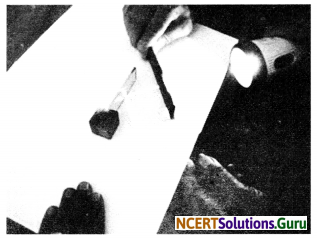
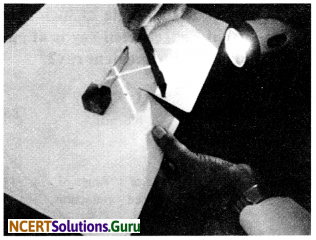
The incident ray, the reflected ray and the normal at the point of incidence lie in the same plane
Question 6.
Fill in the blanks in the following:
a. A person 1 m in front of a plane mirror seems to be …………….. m away from his image.
b. If you touch your …………….. ear with right hand in front of a plane mirror it will be seen in the mirror that your right ear is touched with ……………..
c. The size of the pupil becomes …………….. when you see in dim light.
d. Night birds have …………….. cones than rods in their eyes.
Answer:
a. 2,
b. left left hand,
c. large,
d. less
Choose the correct option in Questions 7-8.
Question 7.
Angle of incidence is equal to the angle of reflection.
a. Always
b. Sometimes
c. Under special conditions
d. Never
Answer:
a. Always
Question 8.
Image formed by a plane mirror is
a. virtual, behind the mirror and enlarged
b. virtual, behind the mirror and of the same size as the object
c. real at the surface of the mirror and enlarged
d. real, behind the mirror and of the same size as the object.
Answer:
b. virtual, behind the mirror and of the same size as the object
![]()
Question 9.
Describe the construction of a kaleidoscope.
Answer:
A kaleidoscope is composed of a hollow tube. Three mirrors are placed in the form of a triangular tube with their reflecting surfaces facing each other. One end of the tube is covered with a transparent sheet and another end is covered with an opaque sheet. There is an eyehole in the opaque sheet. Bits of glass are filled inside the tube. When a kaleidoscope is turned, we get to see various patterns in it. These patterns are formed because of multiple reflections.
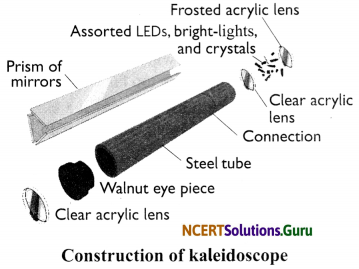
Question 10.
Draw a labelled sketch of the human eye.
Answer:
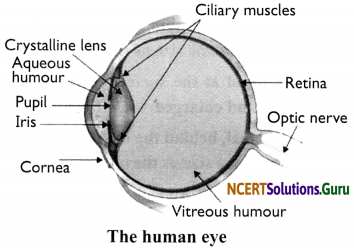
Question 11.
Gurmit wanted to perform Activity 16.8 (of NCERT textbook) using a laser torch. Her teacher advised her not to do so. Can you explain the basis of the teacher’s advice?
Answer:
Laser light is harmful for the human eye, because its intensity is very high. It can cause damage to the retina and lead to blindness. Hence, it is advisable not to look at a laser beam directly.
Question 12.
Explain how you can take care of your eyes.
Answer:
Some tips for care of eyes are as follows:
- Do not read in too bright or too dim light.
- Do not look directly at a bright object or at the sun.
- Do not keep the book too close to your eyes, while reading. Do not keep the book too far either.
- If something gets into the eye, do not rub the eye. Wash it with cold water.
- In case of any problem, like itching or burning sensation, consult an ophthalmologist. A doctor who specialises in the diseases of eyes is called an ophthalmologist.
Question 13.
What is the angle of incidence of a ray if the reflected ray is at an angle of 90° to the incident ray?
Answer:
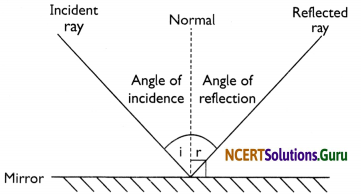
Given: ∠i + ∠r = 90° …….. (i)
We know that, ∠i = ∠r (Law of reflection)
Replacing ∠r in equation (i) with ∠i, we get
∠i + ∠i = 90°
or 2 ∠i = 90°
or ∠i = \(\frac{90^{\circ}}{2}\)
or ∠i = 45°.
Question 14.
How many images of a candle will be formed if it is placed between two parallel plane mirrors separated by 40 cm?
Answer:
When the mirrors are parallel to each other, we get infinite number of images.
![]()
Question 15.
Two mirrors meet at right angles. A ray of light is incident on one at an angle of 30° as shown in figure. Draw the reflected ray from the second mirror.
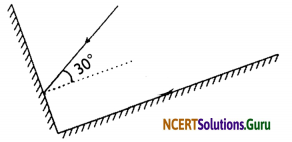
Answer:
The laws of reflection are used to obtain the path of reflected light.

It can be observed that the given ray of light will reflect from the second mirror at an angle of 60°.
Question 16.
Boojho stands at A just on the side of a plane mirror as shown in the given figure. Can he see himself in the mirror? Also can he see the image of objects situated at P, Q and R?

Answer:
A plane mirror forms a virtual image behind the mirror. The image is as far behind the mirror as the object is in front of it. A cannot see his image because the length of the mirror is too short on his side. However, he can see the images of objects placed at points P and Q, but cannot see the image of the object placed at point R (as shown in the given figure).
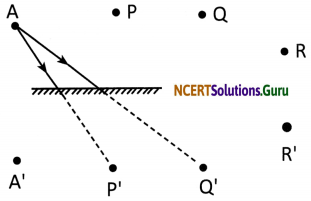
Question 17.
a. Find out the position of the image of an object situated at A in the plane mirror (see figure).
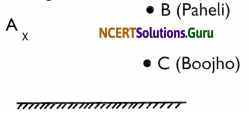
b. Can Paheli at B see this image?
c. Can Boojho at C see this image?
d. When Paheli moves from B to C, where does the image of A move?
Answer:
a. Image of the object placed at A is formed behind the mirror. The distance of the image from the mirror is equal to the distance of A from the mirror. Image of A is shown in the given figure.
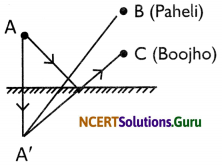
b. Yes. Paheli at B can see this image.
c. Yes. Boojho at C can see this image.
d. Image of the object at A will not move. It will remain at the same position when Paheli moves from B to C.
NCERT Extended Learning Activities and Projects
Question 1.
Make your own mirror. Take a glass strip or glass slab. Clean it and put it on a white sheet of paper. See yourself in the glass. Next put the glass slab on a black sheet of paper. Again look into the glass. In which case you see yourself better and why?
Hint:
We can see our image clearly when the black paper is kept below the glass slab. When we put the glass slab on a white or coloured paper, the light which reflects, reaches our eyes from all directions. However, if we keep a black sheet below the glass slab, the sheet will absorb all the light rays, but our image formed will reflect back to our eyes clearly (since other rays will be absorbed by the black paper).
Question 2.
Make friends with some visually impaired students. Enquire from them how they read and write. Also find out how they are able to recognise objects, hurdles and currency notes.
Hint:
Do it yourself.
Question 3.
Meet an eye specialist. Get your eyesight checked and discuss how to take care of your eyes.
Hint:
Do it yourself.
![]()
Question 4.
Survey your neighbourhood. Find out how many children below the age of 12 years use spectacles. Find out from their parents what, in their view, could be the reason for the weak eyesight of their children.
Hint:
Some common reasons for poor eyesight include lack of sufficient nutrients in diet, e.g., lack of vitamin A, lack of exercise, spending large time on screens like television, computer, cell phone, etc. Unhealthy lifestyle is one of the most common causes of poor eyesight.
Activity 1
Objective: To make a kaleidoscope.
Materials Required: Three rectangular mirror strips (15 cm × 4 cm), cardboard, circular glass plate, broken pieces of glass and coloured beads.
Procedure:
- Take three rectangular mirror strips each about 5 cm long and 4 cm wide.
- Join them as a prism and place inside a circular cardboard tube or tube of a thick chart paper. Make sure that the tube is slightly longer than the mirror strips.
- Close one end of the tube by a cardboard disc having a hole in the center, through which you can see. To make the disc durable, paste a piece of transparent plastic sheet under the cardboard disc.
- At the other end, touching the mirror, fix a circular plane glass plate.
- Place on this glass plate several small pieces of coloured glass, broken pieces of coloured bangles, etc.
- Close this end of the tube by a ground glass plate.
- Allow enough space for the colour pieces to move around.
- Your kaleidoscope is ready. When you peep through the hole, you will be able to see a variety of patterns in the tube.
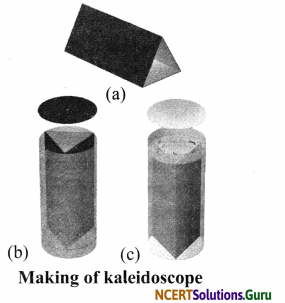
Dispersion: Sunlight or white light is made up of seven colours. Splitting of white light into its constituent colours is called dispersion of light.
![]()
Activity 2
Objective: To show the dispersion of white light.
Materials Required: A plane mirror, a bowl and water.
Procedure:
- Take a plane mirror of a suitable size and place it in a bowl.
- Fill the bowl with water.
- Put this arrangement near a window in such a way that direct sunlight falls on the mirror.
- Adjust the position of the bowl so that the reflected light from the mirror falls on a nearby wall. See what happens.
Observation: Reflected light will be seen to have many colours. As the mirror and water together form a prism, it breaks up the light into its constituent seven colours on the wall.
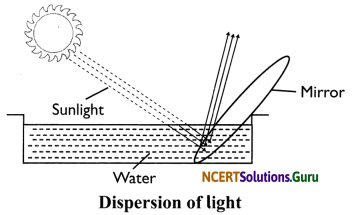
Conclusion: Sunlight is white light. It consists of seven colours and splits into its constituent colours when it is passed through a prism. This is known as dispersion of light.
Human Eye: Eyes are the sense organs which give us the sense of vision. The human eye is almost spherical in shape. Following are the main structures in the human eye:
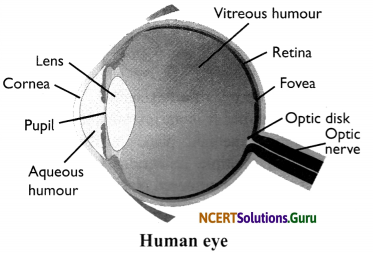
i. Cornea: The eyeball is covered with a tough layer. This layer is transparent on the front. This transparent portion is called cornea.
ii. Iris: Iris is a thin circular structure. It works like the shutter of a camera. It controls the amount of light entering the eye. The colour of iris imparts distinct colour to the eyes of an individual. A person with blue iris has blue eyes.
iii. Pupil: There is a hole in the centre of iris. This is called pupil. Light enters the eye through the pupil. When the light is bright, iris contracts reducing the size of pupil and thus allows less light into the eye. When the light is dim, iris dilates increasing the size of pupil and thus allows more light into the eye.
iv. Lens: Lens is present behind the pupil. The lens in the human eye is a convex lens. The size and thickness of the lens change as per the distance of the object to be viewed.
v. Retina: Retina is at the back of the eye and makes the inner layer of the eyeball. Images are formed on the retina and thus it works like a screen. There are photosensitive cells in the retina. These cells are of two types:
- Cone cells: The cone cells are sensitive to bright light. They also give the sense of colour.
- Rod cells: The rod cells are sensitive to dim light. They do not give the sense of colour.
vi. Optic Nerve: The optic nerve emerges from the back of the eyeball. This nerve goes to the brain and sends messages to the brain to interpret the image.
vii. Blind Spot: The junction of retina and the optic nerve is called the blind spot. There is no photosensitive cell at this spot, and hence no image is formed at this spot of the retina. A yellow spot is located at the centre of the retina. It has maximum concentration of light sensitive cells.
Activity 3
Objective: To recognise the blind spot. Materials Required: A sheet of paper, a pen or a sketch pen.
Procedure:
- Make a round mark and a cross on a sheet of paper with the spot to the right of the cross. The distance between two marks should be 6-8 cm.
- Hold the sheet of paper at arm’s length from the eye.
- Close your left eye. Look continuously at the cross.
- Move the sheet slowly towards you keeping your eye on the cross, and observe.
- Now, close your right eye. Look at the round mark now and repeat the activity.
Observation: In the first case, the round mark disappears while in second case, the cross disappears.

Conclusion: The disappearance of the cross or the round mark shows that there is a point on the retina which cannot send messages to the brain when light falls on it.
Persistence of Vision: An image stays on the retina for about 1/16th of a second. This feature is called persistence of vision. Due to this, when many still images are shown in a sequence at a high speed they give the illusion of moving images. Movies and animations are made by exploiting this property of the human eye.
![]()
Activity 4
Objective: To show that the impression of an image persists for about 1/16th of a second on the retina even after we have stopped seeing the object, sketch pens, etc.
Materials Required: A piece of cardboard, a string, sketch pens, etc.
Procedure:
- Take a square piece of cardboard of size 6-8 cm.
- Make two holes as shown in figure.
- Thread a string through the two holes.
- Draw/paste a cage on one side of the cardboard and a bird on the other side.
- Twist the string and make the card swirl rapidly. Observe what happens.
Observation: On doing so, the bird is seen in the cage.
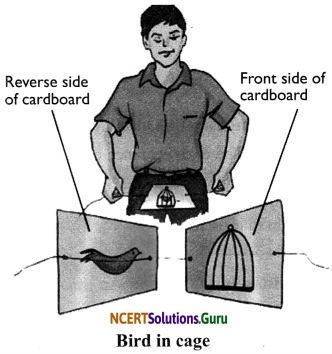
Conclusion: The image of bird persists for 1/16th of a second. The image of cage is formed on the retina in a time less than 1/16th a second. Hence, both the images persist together on the retina and the bird is seen inside the cage. This happens due to persistence of vision.
Range of Normal Vision: The distance between 25 cm and infinity is called the range of normal vision. The most comfortable distance at which one can read with a normal eye is about 25 cm.
Cataract: During old age, the crystalline lens becomes milky and cloudy in a cataract patient and thus the person cannot see clearly. Cataract is treated by surgery. In cataract surgery, the cloudy lens is removed and an artificial lens is transplanted in the eye.
Night Blindness: Night blindness, also called nyctalopia, is a defect of vision in which people cannot view things properly in dim light or at night. It mainly occurs due to the lack of vitamin A in our body. Hence, we should always take meals that are rich in vitamin A such as broccoli, green vegetables, carrot, milk, eggs, curd, papaya, mango, etc.
Non-optical and Optical Aids for Visually Impaired:
Non-optical aids:
- Visual aids: Magnify words, give suitable light intensity.
- Tactual aids: Braille writer slate and stylus.
- Auditory aids: Cassettes, tape recorders, talking books, etc.
- Electronic aids: Talking calculators and computers, CCTV (closed circuit television), etc.
Optical aids: Bifocal lenses, contact lenses, tinted lenses, magnifiers and telescopic aids.
Louis Braille: Louis Braille was bom in 1809 in France. He became blind during early childhood because of an accident. He developed the Braille script in 1824.
Braille Script: The Braille scripts are written in the form of raised dots. This system is composed of 63 characters. Each character is written on a grid of 6 ceils. This can be written with the help of Braille slate and stylus. A reader needs to touch the Braille script to read it.
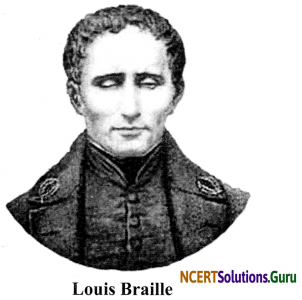
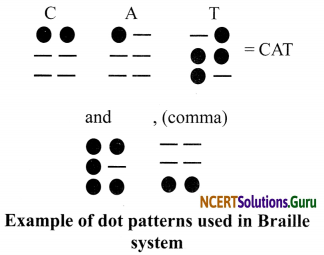
Care of Eyes: Eyes are very important organs and they are sensitive too. So, proper care of eyes is very important. Some tips for care of eyes are as follows:
- Do not read in too bright or too dim light.
- Do not look directly at a bright object or at the sun.
- Do not keep the book too close to your eyes, while reading. Do not keep the book too far either.
- If something gets into the eye, do not rub the eye. Wash it with cold water.
- In case of any problem, like itching or burning sensation, consult an ophthalmologist. A doctor who specialises in the disease of eyes is called an ophthalmologist.
Class 8 Science Chapter 16 Light Additional Important Questions and Answers
Very Short Answer Type Questions
Question 1.
What is light?
Answer:
Light is a form of energy which gives the sensation of vision.
Question 2.
What is reflection of light?
Answer:
When light falls on a shiny surface, most of it bounces back. This phenomenon of bouncing back of light after striking a surface is called reflection of light.
Question 3.
What is incident ray?
Answer:
The ray of light falling on a reflecting surface is called incident ray.
Question 4.
What is reflected ray?
Answer:
The ray of light coming back from a reflecting surface after reflection is called reflected ray.
![]()
Question 5.
What is angle of reflection?
Answer:
The angle between the reflected ray and the normal is called angle of reflection.
Question 6.
What is persistence of vision?
Answer:
An image stays on retina for 1/16th of a second. This is called persistence of vision.
Question 7.
Which phenomenon is responsible for the creation of rainbows?
Answer:
Dispersion of light.
Question 8.
At which part of the eye there is no sense of vision?
Answer:
Blind spot.
Question 9.
Name the cells of retina which are responsible for vision during daytime.
Answer:
Cones.
Question 10.
What type of reflection forms an image?
Answer:
Regular reflection forms an image.
![]()
Question 11.
Who invented the Braille system?
Answer:
Louis Braille, a visually challenged person, developed the Braille system.
Question 12.
What is the use of kaleidoscope?
Answer:
Designers of wallpapers, fabrics, artists use kaleidoscope to get ideas for new patterns.
Question 13.
What are the common defects of vision?
Answer:
Myopia, hypermetropia, cataract and presbyopia.
Question 14.
Name the small opening in the iris.
Answer:
Pupil.
Short Answer Type Questions
Question 1.
How does light enable us to see something?
Answer:
When light falls on an object, some of the light is reflected back to our eyes. Thus, we are able to see an object because of light being reflected from the object.
Question 2.
Describe the dispersion of light by a prism.
Answer:
When light falls on one of the faces of the prism, it gets split up into seven colours while emerging out of the other face of the prism. This band of colours is called spectrum and the phenomenon is called dispersion of light.
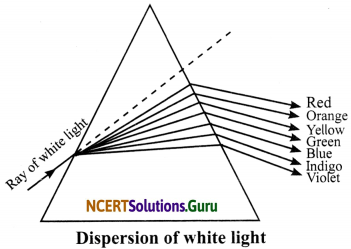
Question 3.
Why in old ages does the eyesight become foggy? How can this defect be removed?
Answer:
Sometimes, particularly in old age, eyesight becomes foggy. It is due to the eye lens becoming milky and cloudy. When it happens, persons are said to have cataract. There is a loss of vision, sometimes extremely severe. It is possible to treat this defect. The opaque lens is removed and a new artificial lens is inserted. Modem technology has made this procedure simpler and safer.
![]()
Question 4.
Do we see all objects due to reflected light?
Answer:
Nearly everything around us is visible due to reflected light. Moon, for example, receives light from the sun and reflects it. That is why we see the moon. These objects are called illuminated objects. There are other objects which give their own light such as the sun, fire, flame of candle, electric lamp and others. These are known as luminous objects. Hence, only illuminated objects are seen due to reflected light.
Question 5.
Movies that we see are a collection of separate pictures that we see as moving. How?
Answer:
The impression of an image does not vanish immediately from the retina. It persists there for about 1/16th of the second. So, if the images flash on the eye at a rate faster than 16 images per second, the eye perceives a moving picture of the objects. The movies that we see are actually separate pictures. They are made to move across the screen usually at the rate of 24 per second (faster than 16 per second).
Question 6.
How many kinds of cells are found in the retina of the eye? What are their functions?
Answer:
There are two kinds of cells in retina:
- Cones which are sensitive to bright light and give a sense of colour.
- Rods which are sensitive to dim light.
Question 7.
Explain the function of the muscles attached to the lens of the eye.
Answer:
In order to see the nearby objects, muscles attached to the lens contract and the lens becomes thicker. On the other hand, muscles relax and the lens becomes thinner when distant objects are to be seen. This changing of the thickness of the eye lens is called accommodation.
Question 8.
Why should one include the vitamin A rich eatables in their diet? What are the main sources of vitamin A?
Answer:
Lack of vitamin A in foodstuff is responsible for many eye troubles. Most common amongst them is night blindness. One should, therefore, include the components which have vitamin A in their diet. Raw carrots, broccoli and green vegetables such as spinach (palak), methi, amaranth and cod liver oil are rich in vitamin A. Eggs, milk, curd, paneer, butter, ghee and fruits such as papaya, banana, mango, apple, dates, etc., also contain plenty of vitamin A.
Question 9.
What are the non-optical and optical aids for visually challenged persons?
Answer:
There are many resources which enable the visually challenged persons to develop their capabilities. These resources can be of two types: non-optical aids and optical aids.
Non-optical aids:
- Visual aids: Magnify words, give suitable light intensity.
- Taxtual aids: Braille writer slate and stylus.
- Auditory aids: Cassettes, tape recorders, talking books, etc.
- Electronic aids: Talking calculators and computers, CCTV (closed circuit television), etc.
Optical aids: Bifocal lenses, contact lenses, tinted lenses, magnifiers and telescopic aids.
![]()
Question 10.
What are the characteristics of image formed by a plane mirror?
Answer:
Characteristics of image formed by a plane mirror are as follows:
- Obtained image is always formed behind the mirror.
- Obtained image is virtual, i.e., it cannot be obtained on screen.
- Image is erect and laterally inverted.
- Image size is equal to object size.
- Distance of the object and image from the mirror is the same.
Long Answer Type Questions
Question 1.
How will you trace image formation in plane mirror?
Answer:
Image formation on plane mirror:
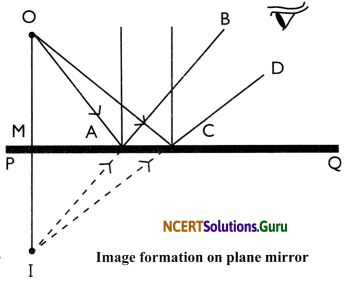
In this figure, PQ is the plane mirror and O is an object. OA and OC are the incident rays, coming from the object. The incident rays are reflected from the mirror and reflected rays emerge as AB and CD. If AB and CD are extended behind the mirror, they appear to meet at point ‘I’. This is the point where image is formed. If OM is object distance and MI is image distance, then in plane mirror, OM = MI. This means image distance is equal to object distance in case of a plane mirror.
Question 2.
Explain the structure of human eye.
Answer:
The human eye is roughly spherical in shape and has the following main parts:
a. Cornea: The eyeball is covered with a tough layer which is transparent on the front. This transparent portion is called cornea.
b. Iris: Iris is a thin circular structure. It works like the shutter of a camera. It controls the amount of light entering the eye. The colour of iris imparts distinct colour to the eyes of an individual. A person with blue iris has blue eyes.
c. Pupil: There is a hole in the centre of iris. This is called pupil. Light enters the eye through the pupil.
d. Lens: Lens is present behind the pupil. The lens in the human eye is a convex lens. The size and thickness of the lens change as per the distance of the object to be seen.
e. Retina: Retina is present at the back of the eye and marks the inner layer of the eyeball. Images are formed on the retina and thus it works like a screen. There are photosensitive cells in the retina. These cells are of two types:
- Cone cells: The cone cells are sensitive to bright light. They also give the sense of colour.
- Rod cells: The rod cells are sensitive to dim light.
f. Optic Nerve: The optic nerve emerges from the back of the eyeball. This nerve goes to the brain for inteipretation of the image.
g. Blind Spot: The junction of retina and the optic nerve is called the blind spot. There is no photosensitive cell at this spot, and hence no image is formed at this spot on the retina.
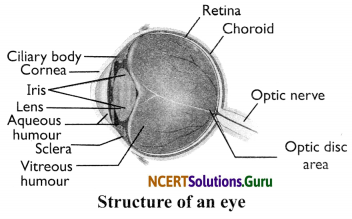
Question 3.
What is Braille system? Explain how the English alphabets are written in this
Answer:
Braille is a system that uses combinations of raised dots to spell letters and numbers. It is used by people who are blind or partially sighted to help them read and write. Braille is not actually a language. It is a system of writing. This system was invented by Louis Braille. Louis Braille was born in 1809 in France. He became blind due to an accident in childhood. He developed the Braille script in 1824.
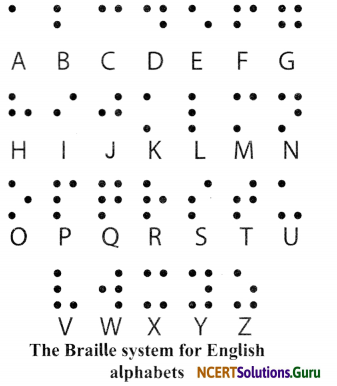
This system has 63 raised dot patterns or characters. Each character or pattern represents a letter, a combination of letters, a common word or a grammatical sign. Dots are arranged in cells of two vertical rows of three dots each. A reader needs to touch the Braille script to read it.
![]()
Question 4.
What are the uses of a plane mirror?
Answer:
Uses of plane mirrors are as follows:
a. Plane mirrors are used as looking glasses at homes, by hair dressers, and many more.
b. Plane mirrors also have many scientific uses. In most of the measuring instruments, a plane mirror is placed under the scale and pointer. When the pointer moves, the image in the plane mirror also moves. Now, the eye is so placed that the pointer covers its own image, and thus the pointer and its image coincide. Thus the eye, the pointer and its image in the mirror are in the same line perpendicular to the scale. This helps in getting the correct reading.
c. Plane mirrors are also used in constructing periscope which is used in submarines.
d. Plane mirrors are used in solar cookers.
e. Plane mirrors are used to make kaleidoscope, a toy which produces beautiful patterns from coloured paper, pieces of glass or small coloured beads.
f. They are used in headlights of vehicles and in torches as reflectors.
Picture Based Questions
Question 1.
Draw the diagram of: (a) Regular reflection (b) Irregular reflection.
Answer:
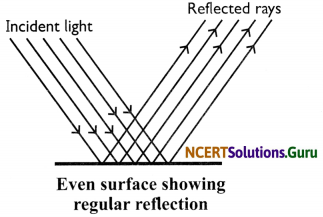
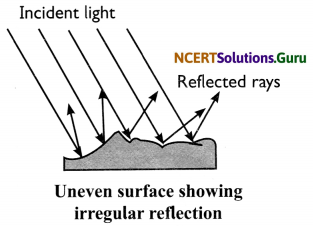
Question 2.
Observe the figure and answer the following questions.

a. Identify and name the system shown here.
b. Who developed this system?
c. How many total characters are there in this system?
d. What kind of people are benefitted from this and how?
Answer:
a. Braille system.
b. Louis Braille.
c. 63
d. It helps the visually impaired people to read and write by feeling the raised dots and recognising the character.